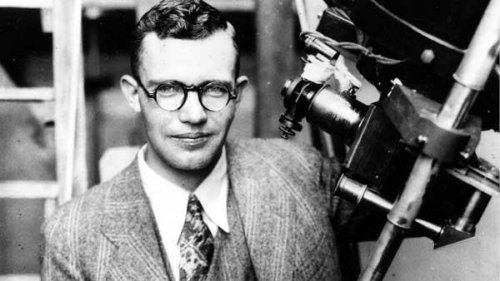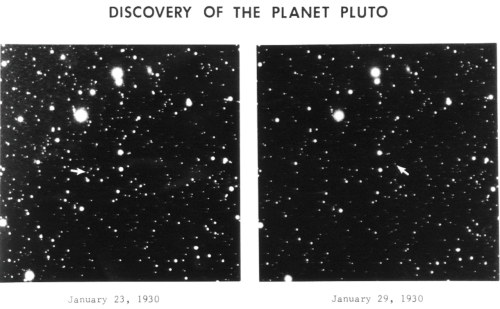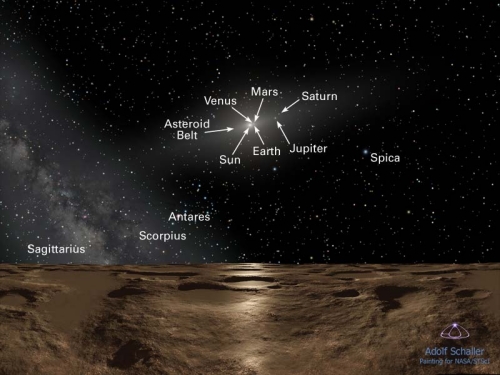Exoplanet hunter Greg Laughlin (UC-Santa Cruz), who could make a living as a poet (if it were possible to make a living as a poet) wrote recently of his hope for a Pluto image ” that will become a touchstone, a visual shorthand for distance, isolation, frigidity and exile.” We haven’t seen that one yet, but I suspect we will with one of the images we’re still to receive showing New Horizons’ view of a receding crescent Pluto again being folded into the deep.
Last night’s reacquisition of the New Horizons’ signal sets us up for many weeks of data return, and provides a triumphant exclamation point on the flyby. Our spacecraft punched right through the orbital plane of Pluto’s system and emerged unscathed. The joy and festivity apparent on those actually at JHU/APL and the wild and celebratory conversations on social media bring home how popular this diminutive spacecraft has become. What an accomplishment, and even now I’m wondering what advances in technology could do in an outer system follow-up.
Clyde Tombaugh’s Apparatus
But I also found myself thinking of that portion of Clyde Tombaugh’s ashes that are now further from us than Pluto. Recently I mentioned Michael Byers’ fine novel Percival’s Planet (Henry Holt, 2010), which contains a fictional account of the discovery of Pluto, seen through the eyes of Byers’ protagonist, an astronomer named Alan Barber, who works with the same equipment Tombaugh uses. Weaving fictional characters in with historical personages like Tombaugh, Vesto Slipher and Percival Lowell, Byers re-creates the era and the task. Here he’s talking about the ‘blink comparator’ methods employed in the hunt for ‘Planet X’:

It is dreadful work, the blinking. You have two exposures of the same area of sky — long exposures a week apart or so; then the two exposed plates, ten inches square, are placed side by side in the big new Bosch, all brass fittings and an urgent smell of electricity and heated gas. Looking through an eyepiece you can see a very small portion of one of these plates — an area roughly the size of a nickel, showing about two hundred stars. Then you hit a switch and the comparator will show you the identical area of the other plate. And if you have managed against all odds to expose your two plates identically — if you’ve got the differential right, and the timing, and moreover if the weather hasn’t been hazy one night and clear the next, and if the telescope hasn’t slipped or jarred or just been slightly misaimed for some reason, and then if you’ve managed in the basement darkroom to develop both plates the same way — well, then you will see the same two hundred stars, looking the same way, appear again in the eyepiece as the blinker shows you the second plate.
The trick is to find a ‘star’ that vanishes or brightens or does something odd between one plate and another. You might be looking at a Cepheid variable, or you might find the track of an asteroid, or if you really get lucky, maybe you’ll find Planet X. Credit Clyde Tombaugh with a magnificent persistence. You can see from the discovery plates just how tricky this work was.

Next Steps in the Outer System
It was fifty years ago yesterday that Mariner 4 reached Mars, a fitting time to think about how far we have come and where we might go next. In What About the Next Pluto Mission?, Centauri Dreams regular Andrew LePage tackles the question of Pluto follow-ups, noting that given how infrequently we have low-energy launch opportunities, and considering the flight times necessary to reach Pluto, we should start thinking about an encore right now. We have a launch opportunity at the end of 2028 and the beginning of 2029 that LePage finds attractive. But there are other options depending on trajectory that he’s careful to analyze.
A follow-on mission, even a flyby, would benefit from advances in technology, remote sensing and miniaturization, allowing for more data to be collected, but LePage also speculates on the possibility of a design that would allow us to multiply our observing chances:
Depending on the available payload margin and, just as importantly, the new mission’s budget, it may prove possible to carry several lightweight but very capable sub-probes, with masses perhaps on the order of tens of kilograms, that the main spacecraft could deploy weeks or months before its 2039 Pluto encounter. These lightweight sub-probes could be directed to make observations of Pluto, Charon, or its other moons at closer range or under different viewing conditions than might be possible with the main spacecraft. This tactic would add flexibility to mission planning as well as the quantity and quality of the scientific data returned. While a traditional entry probe would be of little use in the thin atmosphere of Pluto (which has an estimated surface pressure on the order of a few microbars), a properly equipped sub-probe could be aimed to fly hundreds or maybe even tens of kilometers above Pluto’s surface to directly sample its atmosphere and any aerosol or cloud layers that may exist.
Moreover, there are various ‘energetically favorable’ launch windows in the early 2030s that could get flyby spacecraft to Uranus or Neptune, a follow-up to the grand work of the Voyagers. LePage suggests three separate missions to be launched toward Pluto, Uranus and Neptune in the 2028-2034 timeframe. Dedicated orbiters are, of course, the best choice for maximizing data return, but fast flybys give us the chance to get to the outer system again before any orbiters we choose to send arrive, which presumably wouldn’t be any earlier than mid-century.
The Allure of Sedna
Meanwhile, in At Pluto, the End of a Beginning, Lee Billings makes the case for renewed study of the outer system with his usual elegance. Even before we see the images and data we will be receiving over the next 16 months, we can take heart from the remarkable number of interesting features we’ve found:
Pluto bears a bright polar cap of methane and nitrogen ice, and mottled regions at its equator that signal strange and complex geology. Charon, by contrast, harbors a mysteriously dark polar region apparently bereft of bright ice, and an impact-generated chasm deeper and longer than Earth’s own Grand Canyon. More and better images will soon stream down from New Horizons’ far-distant memory banks, no doubt filled with even greater wonders – perhaps signs of ice volcanoes, or of ancient frozen seas, or of things so strange and unexpected they cannot yet be imagined. The only thing unimaginable is that they will contain nothing tantalizing enough to someday call us back.
All the questions seem to be multiplying. Why is Eris more massive than Pluto, a question that resonates even as we debate whether or not Pluto may not in fact be a bit larger? Surely there are major differences in composition, but why did these occur? And on beyond Eris there remains the king of outer system puzzles. Sedna’s orbit, which goes out thirty times as far as Neptune’s at aphelion, seems to imply gravitational nudges from something else. Is there, Billings asks, a planet as large as several Earth masses waiting to be discovered? And we can add, is Sedna itself a capture from a primordial stellar flyby, an object from another star?

Image: An artist’s impression of the view from Sedna, with points of interest labeled. Credit: Adolf Schaller/NASA.
The questions abound, and we’ll start to tackle at least of few of them when New Horizons goes on to visit a Kuiper Belt Object, assuming an extended mission is approved (it’s hard to see it being rejected at this point). And closer in, we have only fragmentary looks at major satellite systems like those of Uranus and Neptune. Billings and LePage are pointing to what we need to be thinking about as we plan the next steps beyond New Horizons, a process that, given the length of time it takes to develop a mission and a spacecraft, we should have already begun.



whats required id the decadal survey small fission reactor coupled to a stirling engine for deep space SEP
I find it extremely ironic that fifty years ago yesterday around 9 PM, I sat, eyes glued to the TV, when the first image of Mars from Mariner 4 was made public. I was just 13 at the time(just eleven days away from my 14’th birthday) I had no idea what the picture on the TV screen was and what it meant geologically. All I knew at the time was that we were no longer an earth-bound species. Immediately after the picture came up, I turned off the TV and went to bed, CHANGED FOREVER! 50 years later, the same thing happened, except with a laptop, instead of TV, and conformation of carrier signal aquisition, instead of a picture, AGAIN, at around 9PM (or, EXACTLY 50 YEARS LATER)! Again, I immediately went to bed knowing that we had COMPLETED the task initiated EXACTLY 50 YEARS AGO TO THE HOUR!
What a beautiful artist’s impression of the view from Sedna. With NASA’s CEV as a bus for carrying humans further out into the solar system, we have Pluto and Sedna to explore and the many yet to be discovered Kuiper Belt and Oort Cloud object.
Hopefully, enterprises such as the Ad Astra Rocket Company and the like can get us beyond ordinary chemical rocket to enable manned and womanned flight to these objects this Century as a pre-curser to human missions to other stars.
For those interested in more background on the Mariner 4 encounter with Mars a half century ago:
http://www.drewexmachina.com/2015/07/14/mariner-4-to-mars/
” And we can add, is Sedna itself a capture from a primordial stellar flyby, an object from another star?”
Could be. Another possibility could Senda be a rare capture from the Oort cloud? There is a rare three body process for doing this. Every long period comet we know about is probably new, never having passed into the inner solar system before. There are hints that some of the strange KBO’s may have been captured from long period comet flux.
The pictures today at the press conference did not disappoint. Ice mountains on Pluto. A chasm perhaps six miles deep on Charon. And great diversity everywhere. In a year or so, expect to be able to do 3D flyovers with “Google Pluto”. In the meantime, it will simply get better and better as more detailed data streams down over the next year and a half.
It makes one want to return and get much closer for much longer. Or to send swarms of little vehicles back there for a multiplexed fast flyby. To that end, has anyone looked at the possibility of a “sunjammer” type trajectory to really boost the outbound speed?
The one I’d like to see close up is Haumea. It is profoundly strange: a world large enough to be a dwarf planet, but spinning so fast (its day is 3 hours long) that it’s not simply oblate, but stretched out like an American football tumbling end over end, almost as big as Pluto along its longest axis. The gravity would vary significantly over its surface. And it has at least two moons of its own.
Andrew, that idea is becoming more and more appealing to me. While a regular type of spacecraft, such as New Horizons, can collect many types of data along with images, the transit time to get out there (with its risks of something breaking onboard, enroute) makes such missions expensive and rare ventures. But:
Simple microwave- or laser-pushed sail (or “chip-sail”) probes, which could be powered by the beam that pushes them, could be “sprayed” (to use Ronald Bracewell’s term) at outer solar system bodies of interest. A “swarm” wouldn’t even be necessary–a “stream” of such probes, launched in succession, could have imagers and instruments (one or two instruments per probe) distributed among all of them, so that each individual probe could be simple and cheap. In a stream of, say, 500 probes, every fifth one might have an imager, while every fourth one could have a magnetometer, with the other instruments being similarly distributed among the probe stream. Also:
Losing a few probes to internal failures or debris impacts wouldn’t ruin the mission, because launching so many of them would provide redundancy. Being much faster than rocket-boosted spacecraft, such probes could reach their targets in much shorter times (a feature that will become very attractive if even faster, more advanced versions are eventually sent off to investigate our stellar neighbors).
Matt McIrvin writes:
Haumea is a personal interest of mine. You might be interested in a Haumea mission concept (from European sources) that I discussed here a few years back.
‘Fast Orbiter to Haumea’
https://centauri-dreams.org/?p=8680
and ‘Haumea: Technique and Rationale’:
https://centauri-dreams.org/?p=8696
Is there an estimate for how long Charon has been a captured moon
of Pluto? It seems to me that it probably in the 2nd half of the solar systems
existence or sooner. With all that tidal stress an friction between them isn’t
Charon losing orbital energy, gradually? If the final outcome is a collision
how long in the distant future is it likely to Occur?
Some questions on a return mission…
1) Can we use a xenon ion engine similar to Dawn mission to get there fast and then brake into orbit, then reposition to orbit around charon, other KBOs etc? Pluto is awesome but it seems that we missed the most interesting side just by sheer luck. An orbiter would be great.
2) Can we send a lander such as the Mars Curiosity rover? How much modification would this machine require to operate on the colder Pluto? Obviously we’d need it to have a much higher level of autonomy, and a bigger hunk of Plutonium in the RTG.
3) If we sent a New Horizons type mission to Sedna or Eris respectively, and assuming the same level of Jupiter gravity assist was available, what would be the flight time to each? I’m 53 and I hope I can be around to see this stuff happen.
-Mark
@Mark July 16, 2015 at 14:40
Some great questions, Mark! I’ll do my best to answer them.
1) A capable ion propulsion system like that being used by Dawn would potentially open up a large range of possibilities for missions to Pluto, Uranus and Neptune. A smaller orbiter with shorter transit times would be possible compared to using chemical propulsion systems. Unfortunately, the really big gains would require the development of a nuclear reactor (since sunlight in the outer solar system would render solar panels useless). Aside from the environmental concerns of some in our country that would complicate development, the US has only launched a single nuclear reactor into space for engineering testing and that was 50 years ago.
http://www.drewexmachina.com/2015/04/03/50-years-ago-today-the-first-nuclear-reactor-in-orbit/
The development of the needed nuclear reactor technology will take time and cost a fair amount, assuming it is politically possible. There are some Uranus and Neptune orbiter mission concepts that use RTGs to run low power ion propulsion for orbit insertion, but they are envisioning arrival times in the 2050s and even the 2060s!
2) A Curiosity-type rover modified for the lower gravity and MUCH colder environment on Pluto is certainly technologically feasible. However, because of the thin atmosphere of Pluto, aerobraking would be impractical so a new all-rocket propulsion braking system would have to be devised. Also, with a payload of this size, this mission would only be practical with a reliable nuclear-electric propulsion system and have a cost in the multi-billion dollar range.
3) I have yet to see any studies for JGA trajectory studies for Sedna or Eris but such flights are certainly possible with a fast-flyby mission like I have proposed. Flight times of on the order of a decade or so are possible for Eris but reaching Sedna may take a couple of decades or more to reach because it is so much farther away than Pluto
Hope I was able to answer your questions. Like you, I am 53 and hope to see additional missions to Uranus, Neptune, Pluto and new missions beyond in my life time. Unfortunately, the fast flyby missions I propose might be the only chance we grey beards have to see these worlds revisited. Orbiter and lander missions are looking more and more likely to reach their targets by mid-century and beyond.
NASA’s SAFE-400 space nuclear reactor might make an electric propulsion powered visit to Pluto possible at only a 3 to 4 year transit time. You would need high power to make the fast transit and to slowdown before arriving at Pluto.
Bob Clark
Bob Clark
The optimal time to visit Sedna is around 2075-2076, I’m not really sure how many of us is still around watching a flyby this time. On the other hand, we’ll have quasi-AI doing tons of interesting stuff at the inner region.